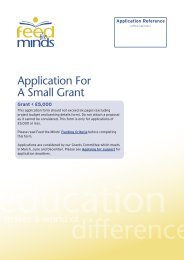Female Genital Mutilation practices in Kenya: - Feed the Minds
Female Genital Mutilation practices in Kenya: - Feed the Minds
Female Genital Mutilation practices in Kenya: - Feed the Minds
Create successful ePaper yourself
Turn your PDF publications into a flip-book with our unique Google optimized e-Paper software.
8.<br />
Although religion, aes<strong>the</strong>tics and social culture<br />
have been identified as features which contribute<br />
to <strong>the</strong> practice 4 , FGM rema<strong>in</strong>s primarily a cultural<br />
ra<strong>the</strong>r than a religious practice, occurr<strong>in</strong>g<br />
across different religious groups. FGM is not<br />
sanctioned by any religious texts. Although <strong>in</strong> some<br />
communities, religious <strong>in</strong>terpretations have been<br />
used to justify <strong>the</strong> practice. Hygiene and aes<strong>the</strong>tics<br />
are frequently quoted as factors support<strong>in</strong>g FGM,<br />
often underp<strong>in</strong>ned by beliefs that female genitalia<br />
are ugly, have a bad odour and can be made more<br />
beautiful by FGM. FGM is also seen as an essential<br />
step <strong>in</strong> mark<strong>in</strong>g <strong>the</strong> transition of a girl <strong>in</strong>to a mature<br />
woman, able to carry out <strong>the</strong> roles assigned to<br />
a woman, <strong>in</strong>clud<strong>in</strong>g marriage and childbear<strong>in</strong>g.<br />
FGM is also considered as help<strong>in</strong>g curb sexual<br />
drive and respect<strong>in</strong>g cultural/traditional heritage.<br />
PrevAlence oF FGm<br />
S<strong>in</strong>ce <strong>the</strong> 1990s, national and sub-national data<br />
collection on FGM has taken place <strong>in</strong> more than<br />
20 countries through <strong>the</strong> Demographic and Health<br />
Surveys (DHS), prompted <strong>in</strong> part at least by Toubia’s<br />
report, <strong>Female</strong> <strong>Genital</strong> <strong>Mutilation</strong>: A call for<br />
Global Action 5 . The collation of data by population<br />
characteristics such as age, ethnicity, religion,<br />
residence and education has enabled some of <strong>the</strong><br />
key factors <strong>in</strong>fluenc<strong>in</strong>g <strong>the</strong> prevalence of FGM to<br />
be better understood 3 . The picture which emerges<br />
is complex, with strong regional differences <strong>in</strong> <strong>the</strong><br />
prevalence of FGM <strong>in</strong> many countries, usually mirror<strong>in</strong>g<br />
<strong>the</strong> homelands of specific ethnic communities.<br />
In most, but not all countries, FGM prevalence<br />
is higher <strong>in</strong> rural than urban areas. There is also<br />
some evidence that education plays a role, with<br />
<strong>the</strong> daughters of well-educated women be<strong>in</strong>g less<br />
likely to be circumcised. There are exceptions,<br />
however, for <strong>in</strong>stance <strong>in</strong> Egypt, where education<br />
appears not to make a difference to whe<strong>the</strong>r a<br />
young woman is circumcised or not.<br />
4 Mohamud A Ali N and Y<strong>in</strong>ger N (1999) FGM programmes to<br />
date: What works and what doesn’t work. Geneva: WHO/PATH<br />
5 Toubia N (1993) <strong>Female</strong> <strong>Genital</strong> <strong>Mutilation</strong>: A call for Global<br />
Action. New York: Ra<strong>in</strong>bo<br />
<strong>in</strong>ternAtionAl<br />
eFForts on FGm<br />
Attempts to persuade communities to abandon<br />
FGM were first recorded by missionary and<br />
colonial authorities early <strong>in</strong> <strong>the</strong> twentieth century,<br />
and were largely seen as colonial imperialism 3 .<br />
The efforts of western fem<strong>in</strong>ists <strong>in</strong> <strong>the</strong> 1960s<br />
and 1970s were similarly regarded as be<strong>in</strong>g<br />
critical of <strong>in</strong>digenous culture and imposed by<br />
outsiders with <strong>the</strong>ir own agenda. However,<br />
attitudes began to change <strong>in</strong> <strong>the</strong> mid-1990s when<br />
<strong>the</strong> International Conference on Population and<br />
Development (1994) and <strong>the</strong> Fourth World<br />
Conference on Women (1995) took place <strong>in</strong><br />
Beij<strong>in</strong>g, <strong>in</strong> which FGM was portrayed as a health<br />
and human rights issue. It was acknowledged that<br />
efforts to encourage abandonment needed<br />
to <strong>in</strong>clude locally-led <strong>in</strong>itiatives and <strong>the</strong> full<br />
engagement of communities, health professionals<br />
and policy makers.<br />
In 1997, a jo<strong>in</strong>t <strong>in</strong>ternational statement aga<strong>in</strong>st<br />
<strong>the</strong> practice of FGM was issued by <strong>the</strong> World<br />
Health Organization (WHO), <strong>the</strong> United Nations<br />
Children’s Fund (UNICEF) and <strong>the</strong> United<br />
Nations Population Fund (UNFPA). In 2008, a new<br />
statement was released, with wider UN support<br />
and a stronger focus on <strong>the</strong> human rights, legal<br />
and policy dimensions. This statement was based<br />
on <strong>the</strong> research carried out <strong>in</strong> <strong>the</strong> <strong>in</strong>terven<strong>in</strong>g<br />
years, focus<strong>in</strong>g on <strong>the</strong> reasons for <strong>the</strong> cont<strong>in</strong>ued<br />
practice, <strong>the</strong> <strong>in</strong>creased <strong>in</strong>volvement of health<br />
professionals <strong>in</strong> carry<strong>in</strong>g out FGM to reduce <strong>the</strong><br />
health consequences, and <strong>the</strong> impact of various<br />
approaches to encourag<strong>in</strong>g <strong>the</strong> abandonment of<br />
FGM. It stressed that regardless of <strong>the</strong> reasons<br />
for its practice, FGM is harmful and violates <strong>the</strong><br />
rights and dignity of women and girls, <strong>the</strong> rights<br />
to health, security and physical <strong>in</strong>tegrity of <strong>the</strong><br />
person, <strong>the</strong> right to be free from torture and<br />
degrad<strong>in</strong>g treatment, and <strong>the</strong> right to life when<br />
<strong>the</strong> procedure results <strong>in</strong> death. The World Health<br />
Assembly resolution <strong>in</strong> 2008 (WHA61.16) called for<br />
an <strong>in</strong>tegrated approach to end<strong>in</strong>g FGM with<strong>in</strong> one<br />
generation through concerted action across health,<br />
education, f<strong>in</strong>ance, justice and women’s affairs,<br />
focus<strong>in</strong>g on advocacy, research and guidance for<br />
health services.




